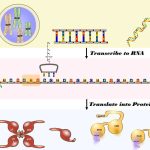Packaging in Prokaryotes:
In prokaryotes like E. coli, a well-defined nucleus is absent.
So, DNA (carrying negative charge) is held together with some proteins (that have positive charge) in a region known as nucleoid. The DNA in nucleoid is organised in nucleus in large loops held by proteins.
Packaging in Eukaryotes:
Reger Kornberg in 1974 reported that chromosome is made up of DNA and protein. The organisation of DNA is much more complex in eukaryotes.
Depending upon the abundance of amino acid residue with charged side chains, a protein acquires its charge.
Histones are the proteins that are rich in lysine and arginine residues.
Both these amino acid residues are basic amino acids and carry positive charges with them. So, histones are a set of positively charged, basic proteins (histones + protamine). These histones organise themselves to make a unit of 8 molecules known as histone octamer.
ADVERTISEMENTS:
The negatively charged DNA is wrapped around the positively charged histone octamer, forming a structure known as nucleosome.
The nucleosome is made up of four types of proteins — H2A, H2B, H3 and H4 occurring in pairs.

One nucleosome contains 200 base pairs of DNA helix, approximately. Nucleosomes are the repeating unit of chromatin, which are thread-like stained (coloured) bodies present in nucleus.
These look like ‘beads-on-string’ when observed under an electron microscope with chromatin.
DNA helix of 200 bp wraps around the nucleosome by 1¾ turns.
The chromatin is packed to form a solenoid structure of 30 mm diameter and further supercoiling tends to form a looped structure called chromatin fibre, which further coils and condense at metaphase stage to form the chromosomes.
Non-Histone Chromosomal (NHC) Proteins:
These are an additional sets of proteins that contribute to the packaging of chromatin at a higher level.
There are following regions present in chromatin:
1. Euchromatin:
These are the regions of chromatin, which are loosely packed (and are stains light) in a typical nucleus.
2. Heterochromatin:
These are the regions of chromatin, which are densely packed (and are stains dark).



Comments are closed